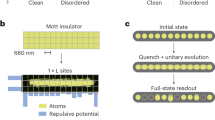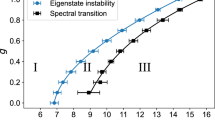Abstract
Gaussian models provide an excellent effective description of many quantum many-body systems ranging from condensed-matter systems1,2 all the way to neutron stars3. Gaussian states are common at equilibrium when the interactions are weak. Recently it was proposed that they can also emerge dynamically from a non-Gaussian initial state evolving under non-interacting dynamics4,5,6,7,8,9,10,11. Here we present the experimental observation of such a dynamical emergence of Gaussian correlations in a quantum many-body system. This non-equilibrium evolution is triggered by abruptly switching off the effective interaction between the observed collective degrees of freedom, while leaving the interactions between the microscopic constituents unchanged. Starting from highly non-Gaussian correlations, consistent with the sine–Gordon model12, we observe a Gaussian state emerging over time as revealed by the decay of the fourth- and sixth-order connected correlations in the quantum field. A description of this dynamics requires a novel mechanism for the emergence of Gaussian correlations, which is relevant for a wide class of quantum many-body systems. In our closed system with non-interacting effective degrees of freedom, we do not expect full thermalization13,14,15,16,17,18,19. This memory of the initial state is confirmed by observing recurrences20 of non-Gaussian correlations.
This is a preview of subscription content, access via your institution
Access options
Access Nature and 54 other Nature Portfolio journals
Get Nature+, our best-value online-access subscription
$29.99 / 30 days
cancel any time
Subscribe to this journal
Receive 12 print issues and online access
$209.00 per year
only $17.42 per issue
Buy this article
- Purchase on Springer Link
- Instant access to full article PDF
Prices may be subject to local taxes which are calculated during checkout



Similar content being viewed by others
Data availability
Source data are provided with this paper. The experimental raw data (absorption images) for Figs. 2 and 3 can be found in ref. 42. All other data are available from the corresponding author upon reasonable request.
References
Girvin, S. M. & Yang, K. Modern Condensed Matter Physics (Cambridge Univ. Press, 2019).
Altland, A. & Simons, B. D. Condensed Matter Field Theory 2nd edn (Cambridge Univ. Press, 2010).
Gandolfi, S., Gezerlis, A. & Carlson, J. Neutron matter from low to high density. Annu. Rev. Nucl. Part. Sci. 65, 303–328 (2015).
Haag, R., Kadison, R. V. & Kastler, D. Asymptotic orbits in a free Fermi gas. Commun. Math. Phys. 33, 1–22 (1973).
Cramer, M., Dawson, C. M., Eisert, J. & Osborne, T. J. Exact relaxation in a class of nonequilibrium quantum lattice systems. Phys. Rev. Lett. 100, 030602 (2008).
Cramer, M. & Eisert, J. A quantum central limit theorem for non-equilibrium systems: exact local relaxation of correlated states. New J. Phys. 12, 055020 (2010).
Sotiriadis, S. & Calabrese, P. Validity of the GGE for quantum quenches from interacting to noninteracting models. J. Stat. Mech. Theory Exp. 2014, P07024 (2014).
Gluza, M., Eisert, J. & Farrelly, T. Equilibration towards generalized Gibbs ensembles in non-interacting theories. SciPost Phys. 7, 38 (2019).
Murthy, C. & Srednicki, M. Relaxation to Gaussian and generalized Gibbs states in systems of particles with quadratic Hamiltonians. Phys. Rev. E 100, 012146 (2019).
Monnai, T., Morodome, S. & Yuasa, K. Relaxation to Gaussian generalized Gibbs ensembles in quadratic bosonic systems in the thermodynamic limit. Phys. Rev. E 100, 022105 (2019).
Ishii, T. & Mori, T. Strong eigenstate thermalization within a generalized shell in noninteracting integrable systems. Phys. Rev. E 100, 012139 (2019).
Schweigler, T. et al. Experimental characterization of a quantum many-body system via higher-order correlations. Nature 545, 323–326 (2017).
Gring, M. et al. Relaxation and prethermalization in an isolated quantum system. Science 337, 1318–1322 (2012).
Langen, T., Geiger, R., Kuhnert, M., Rauer, B. & Schmiedmayer, J. Local emergence of thermal correlations in an isolated quantum many-body system. Nat. Phys. 9, 640–643 (2013).
Langen, T. et al. Experimental observation of a generalized Gibbs ensemble. Science 348, 207–211 (2015).
Schreiber, M. et al. Observation of many-body localization of interacting fermions in a quasirandom optical lattice. Science 349, 842–845 (2015).
Calabrese, P., Essler, F. H. L. & Fagotti, M. Quantum quench in the transverse-field Ising chain. Phys. Rev. Lett. 106, 227203 (2011).
Polkovnikov, A., Sengupta, K., Silva, A. & Vengalattore, M. Colloquium: Nonequilibrium dynamics of closed interacting quantum systems. Rev. Mod. Phys. 83, 863–883 (2011).
Eisert, J., Friesdorf, M. & Gogolin, C. Quantum many-body systems out of equilibrium. Nat. Phys. 11, 124–130 (2015).
Rauer, B. et al. Recurrences in an isolated quantum many-body system. Science 360, 307–310 (2018).
Cuevas-Maraver, J., Kevrekidis, P. G. & Williams, F. (eds) The Sine–Gordon Model and its Applications (Springer Series in Nonlinear Systems and Complexity Vol. 10, Springer, 2014).
Cirac, J. I. & Zoller, P. Goals and opportunities in quantum simulation. Nat. Phys. 8, 264–266 (2012).
Bloch, I., Dalibard, J. & Nascimbène, S. Quantum simulations with ultracold quantum gases. Nat. Phys. 8, 267–276 (2012).
Gritsev, V., Polkovnikov, A. & Eugene, D. Linear response theory for a pair of coupled one-dimensional condensates of interacting atoms. Phys. Rev. B 75, 174511 (2007).
Calabrese, P. & Cardy, J. Time dependence of correlation functions following a quantum quench. Phys. Rev. Lett. 96, 136801 (2006).
Reichel, J. & Vuletić, V. (eds) Atom Chips (Wiley-VCH, 2011).
Schumm, T. et al. Matter–wave interferometry in a double well on an atom chip. Nat. Phys. 1, 57–62 (2005).
Zinn-Justin, J. Quantum Field Theory and Critical Phenomena 4th edn (International Series of Monographs on Physics, Clarendon, 2002).
Kitagawa, T., Imambekov, A., Schmiedmayer, J. & Demler, E. The dynamics and prethermalization of one-dimensional quantum systems probed through the full distributions of quantum noise. New J. Phys. 13, 073018 (2011).
Langen, T., Schweigler, T., Demler, E. & Schmiedmayer, J. Double light-cone dynamics establish thermal states in integrable 1D Bose gases. New J. Phys. 20, 023034 (2018).
Beck, S., Mazets, I. E. & Schweigler, T. Nonperturbative method to compute thermal correlations in one-dimensional systems. Phys. Rev. A 98, 023613 (2018).
Geiger, R., Langen, T., Mazets, I. E. & Schmiedmayer, J. Local relaxation and light-cone-like propagation of correlations in a trapped one-dimensional Bose gas. New J. Phys. 16, 053034 (2014).
Srednicki, M. Quantum Field Theory (Cambridge Univ. Press, 2007).
Efron, B. & Tibshirani, R. Bootstrap methods for standard errors, confidence intervals, and other measures of statistical accuracy. Stat. Sci. 1, 54–75 (1986).
Kuhnert, M. Thermalization and Prethermalization in an Ultracold Bose Gas. PhD thesis, TU Wien (2013).
Tajik, M. et al. Designing arbitrary one-dimensional potentials on an atom chip. Opt. Express 27, 33474–33487 (2019).
Rauer, B. Non-Equilibrium Dynamics Beyond Dephasing: Recurrences and Loss Induced Cooling in One-Dimensional Bose Gases. PhD thesis, TU Wien (2018).
Shiryaev, A. N. Probability-1 3rd edn, 349 (Graduate Texts in Mathematics Vol. 95, Springer, 2016).
Grišins, P. & Mazets, I. Coherence and Josephson oscillations between two tunnel-coupled one-dimensional atomic quasicondensates at finite temperature. Phys. Rev. A 87, 013629 (2013).
Schweigler, T. Correlations and Dynamics of Tunnel-Coupled One-Dimensional Bose Gases. PhD thesis, TU Wien (2019).
van Kempen, E. G. M., Kokkelmans, S. J. J. M. F., Heinzen, D. J. & Verhaar, B. J. Interisotope determination of ultracold rubidium interactions from three high-precision experiments. Phys. Rev. Lett. 88, 093201 (2002).
Schweigler, T. et al. Raw data to ‘Decay and recurrence of non-Gaussian correlations in a quantum many-body system’, arxiv:2003.01808. Zenodo https://doi.org/10.5281/zenodo.3753155 (2020).
Acknowledgements
We thank I. Mazets, S. Erne, T. Gasenzer, J. Berges and T. Langen for helpful discussions. This work is supported by the DFG/FWF Collaborative Research Centre ‘SFB 1225 (ISOQUANT)’, and the ESQ Discovery Grant ‘Emergence of physical laws: from mathematical foundations to applications in many body physics’ of the Austrian Academy of Sciences (ÖAW). F.C., F.S.M., B.R., J. Sabino and T.S. acknowledge support by the Austrian Science Fund (FWF) in the framework of the Doctoral School on Complex Quantum Systems (CoQuS). S.S. acknowledges support by the Slovenian Research Agency (ARRS) under grant QTE (N1-0109) and by the ERC Advanced Grant OMNES (694544). S.-C.J. acknowledges support by an Erwin Schrödinger Quantum Science & Technology (ESQ) Fellowship funded through the European Union’s Horizon 2020 research and innovation programme under Marie Skłodowska-Curie grant 801110. J. Sabino acknowledges support by the Fundação para a Ciência e a Tecnologia (PD/BD/128641/2017). J.E. acknowledges funding from the DFG (FOR 2724, EI 519/9-1, EI 519/7-1, CRC 183), the FQXi and the European Union’s Horizon 2020 research and innovation programme under grant 817482 (PASQuanS). J.E., M.G., J. Schmiedmayer and S.S. thank the Erwin Schrödinger Institute for its hospitality and support under the programme ‘Quantum Simulation—from Theory to Application’ (LCW 2019).
Author information
Authors and Affiliations
Contributions
T.S. performed the experiment and data analysis with contributions by M.T., B.R., F.C., S.-C.J., F.S.M. and J. Sabino. T.S. did the theory calculations with contributions by M.G. and S.S. J. Schmiedmayer and J.E. provided scientific guidance in experimental and theoretical questions. J. Schmiedmayer conceived the experiment. All authors contributed to the interpretation of the data and to the writing of the manuscript.
Corresponding authors
Ethics declarations
Competing interests
The authors declare no competing interests.
Additional information
Peer review information Nature Physics thanks the anonymous reviewers for their contribution to the peer review of this work.
Publisher’s note Springer Nature remains neutral with regard to jurisdictional claims in published maps and institutional affiliations.
Extended data
Extended Data Fig. 1 Additional results for the time evolution of the relative size of the fourth-order connected correlation functions.
As for Fig. 2 (see there for the meaning of the plotted quantities and error bars), but for several different initial phase-locking strengths (quantified by \({\langle \cos (\varphi )\rangle }_{{\rm{init}}}\)) and different trapping geometries. The results for a \({\langle \cos (\varphi )\rangle }_{{\rm{init}}}\) of 0.81 and 0.88 have been obtained with a harmonic confinement. For all other results, a 75 μm long box trap has been superimposed onto the harmonic confinement (Methods). We find that Gaussian correlations emerge dynamically for all measurements, independent of the initial phase-locking strength or the trapping geometry. The speed for the decay of M(4) increases with the initial phase-locking in agreement with our theoretical model. One can understand the trend by realizing that the phase-fluctuations of the initial state get smaller with increasing phase-locking and are therefore more quickly overshadowed by the mixed-in initial density fluctuations.
Supplementary information
Supplementary Information
Supplementary Figs. 1–5, discussion of the experimental results and theoretical model.
Source data
Source Data Fig. 2
Numerical values of the plotted quantities.
Source Data Fig. 3
Numerical values of the plotted quantities.
Source Data Extended Data Fig. 1
Numerical values of the plotted quantities.
Rights and permissions
About this article
Cite this article
Schweigler, T., Gluza, M., Tajik, M. et al. Decay and recurrence of non-Gaussian correlations in a quantum many-body system. Nat. Phys. 17, 559–563 (2021). https://doi.org/10.1038/s41567-020-01139-2
Received:
Accepted:
Published:
Issue Date:
DOI: https://doi.org/10.1038/s41567-020-01139-2
This article is cited by
-
Verification of the area law of mutual information in a quantum field simulator
Nature Physics (2023)
-
Accessing quantum information of field theories with ultracold atoms
Nature Physics (2023)
-
Quantum simulation of thermodynamics in an integrated quantum photonic processor
Nature Communications (2023)
-
Nonlinear interferometry beyond classical limit enabled by cyclic dynamics
Nature Physics (2022)
-
Quantum nonlinear spectroscopy of single nuclear spins
Nature Communications (2022)



